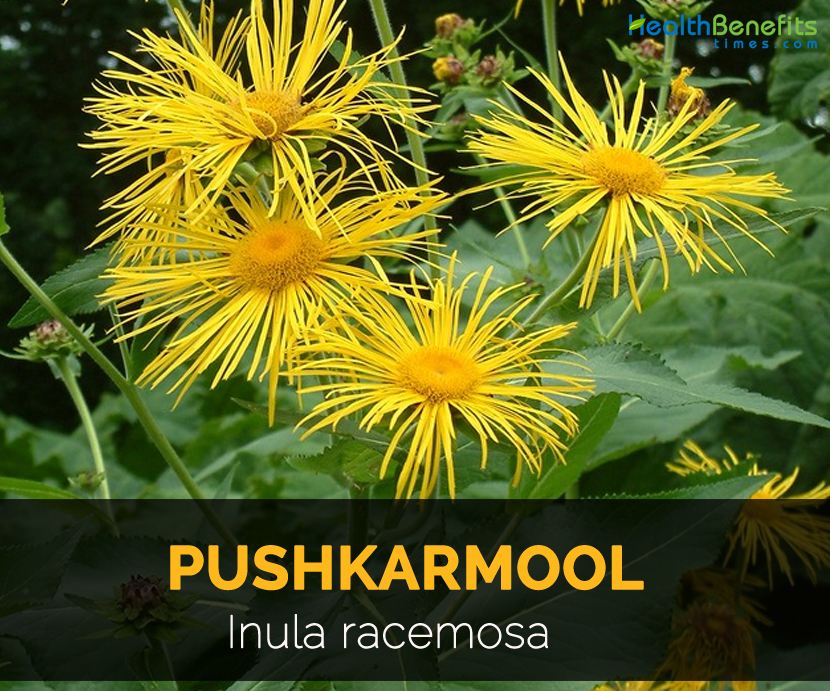| Pushkarmool Quick Facts | |
|---|---|
| Name: | Pushkarmool |
| Scientific Name: | Inula racemosa |
| Origin | Native to the temperate and alpine western Himalayas of Xinjiang, Afghanistan, Kashmir, Nepal, Pakistan. |
| Shapes | Slender achenes, 0.4 cm long |
Phuskarmool is distributed in temperate alpine Himalayas at altitude of 1500 to 4200 from Kashmir to Kumaon, Afghanistan and Central Nepal. It is found in wild among 13 strong vegetation in eastern Leh & Ladakh region of Kashmir. The domesticated forms are found on borders of agricultural fields of barley, wheat and buckwheat both in Kashmir and Lahaul valley of Himachal Pradesh. It is regarded as endangered species due to its fragile nature of habitat and its exploitation due to commercial medicinal properties. The species in entire north western Himalayan range are facing speedy decline and dwindling both in size and number.
Plant description
Pushkarmool is a stout shrub with large leaves arranged in racemose form. It has grooved stems and all vegetative parts are scabid tomentose. The upper leaves are lanceolate, stem clasping and lower leaves are narrowed to winged leaf stack. An abaxial laminal face is densely tomentose. Radical leaves are elliptic lanceolate, 40 x 20 cm broad with long petioles. Cauline leaves are smaller, oblong, semi aplexicaule. The flower blooms in mid to late summer. Flowers are large and shady yellow daisies usually borne on apical spike like cluster. Fruits are slender achenes, 0.4 cm long with 0.75 cm long pappus hairs. Roots are irregularly fusiform and about 20-25 x 5 cm. Roots are yellowish inside with dull brownish skin. It possess sweet, camphoraceous odor with bitter taste.
Traditional uses
- In Ayurvedic classics, it is used for breathlessness, hiccup, coughing and pain in lateral sides of the chest.
- Roots are used as a remedy for dysponea, cough, pleurisy, asthma, chest pain, tuberculosis and pre cordial pain.
- The aqueous extract of dry or fresh roots is used orally in liver problems and rheumatic pains.
- Traditionally roots are used for treating gonorrhea, jaundice and ophthalmic afflictions.
- Leaves are used for respiratory tract affections such as acute or chronic bronchitis.
- Smoke the dried leaves as cigarettes to treat asthma.
- Use the juice of fresh leaves for dysentery, diarrhea and also as antiseptic, anthelmintic and antiperiodic.
- In Kashmir, roots are used as chronic bronchitis, asthma and pulmonary disorders.
- In India, root powder is used for treating tuberculosis, asthma, cardiac disorders, skin diseases, diabetes, obesity and boost appetite.
- In Europe and Asian countries, roots are used to cure cardiac disorders.
- The mixture of Pushkarmool root powder and Commiphora mukul powder is used to cure myocardial ischemia.
- Apply the root paste externally in wounds.
- Inula racemosa is used to treat abdominal pain, swelling, bacillary dysentery, acute enteritis, stimulating spleen, alleviate pain between neck and shoulders, prevent abortion and relieve depression of liver.
- The plant is used to treat tuberculosis by local American people.
- Apply the root powder in teeth for various ailments of teeth, liver diseases, boils and abscess.
- Take root powder with honey for treating heart ailments.
- It triggers kidneys and increases the formation of urine. It clears airways and alleviates dyspnea, hiccups and cough.
- It improves digestion and strengthens digestive tract.
- It promotes cardiac circulation, promote tissue metabolism and relieve weakness.
- It helps to lower menstrual pain and facilitate flow.
- It is useful for cough, cold and fever.
- It also lowers blood pressure and also used to treat anorexia.
Medicinal applications
- Cough and Asthma
Take 1 to 3 grams of root powder.
Take root powder with Dashmoola decoction.
- Dental problems
Apply the root powder in teeth.
- Edema
Take the root powder with lukewarm water.
- Heart disease and Chest pain
Take Pushkarmula powder with honey.
Apply the root paste on chest for chest pain.
- Sprain, boils, bruises, absess
Apply the root paste externally on affected area.
Side-effects
- It reduces blood pressure so people with low blood pressure should avoid it.
- People who are sensitive to Compositae/Asteraceae family plant may experience allergy with the use of this plant.
- Use it in medicinal amounts.
- Pregnant women should avoid it.
- It obstructs with blood sugar control.
- It increases bile.
References:
http://www.plantnames.unimelb.edu.au/Sorting/Inula.html
https://pfaf.org/user/Plant.aspx?LatinName=Inula+racemosa
https://en.wikipedia.org/wiki/Inula_racemosa
https://www.athayurdhamah.com/about-ayurveda/pushkarmool
http://www.aimilpharmaceuticals.com/herbs/pushkarmool/
https://www.bimbima.com/herbs/pushkarmula-medicinal-uses-and-side-effects/71/
https://www.planetayurveda.com/library/pushkarmool-inula-racemosa/
Comments
comments
